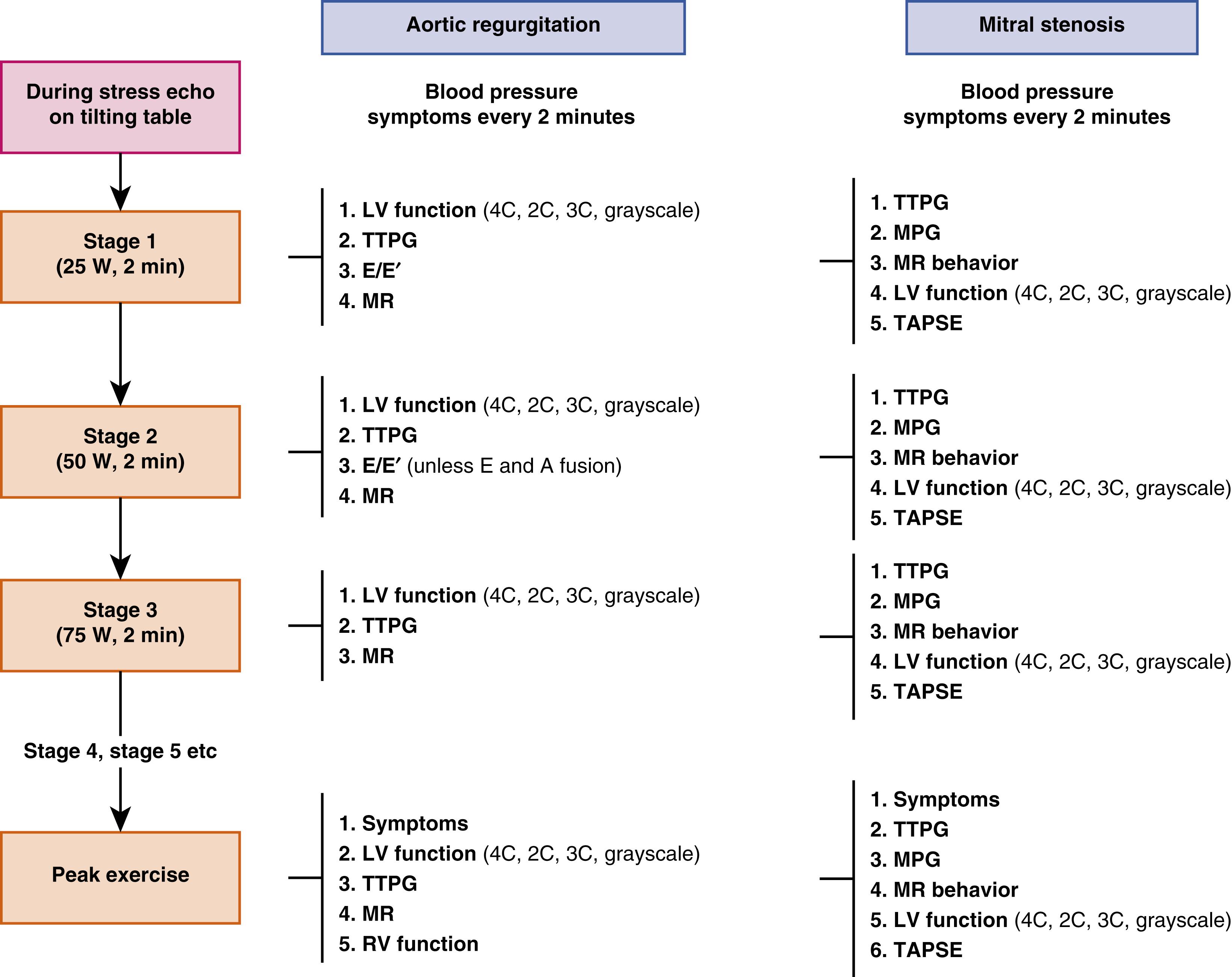Physical Address
304 North Cardinal St.
Dorchester Center, MA 02124
Stress echocardiography (SE) has been less well validated in the context of aortic regurgitation (AR) and mitral stenosis (MS) than for coronary disease and mitral regurgitation (MR). In both these conditions, exercise stress echocardiography (ESE) represents the imaging approach of choice, being especially useful in apparently asymptomatic patients, mainly caused by sedentary lifestyle, and in nonsevere valve disease with symptoms.
Either immediate after exercise (treadmill or upright bicycle ergometer) or during exercise imaging (semisupine bicycle exercise on a tilted table) can be performed. The postexercise echocardiography, although more common worldwide, can be more difficult, especially when multiple stress parameters need to be assessed in the first 1 to 2 minutes after test termination. The semisupine exercise echocardiography, which is more common in Europe, offers the advantage of a continuous evaluation of stress parameters during exercise.
The test should be performed under the supervision of an experienced physician and a nurse. Typically, the initial workload of 25 W is maintained for 2 minutes and increased every 2 minutes by 25 W, but an increase in steps of 10 W can be more appropriate in patients with a low level of physical activity. Blood pressure, heart rate, 12-lead electrocardiography, and echocardiographic parameters related to the valve, the left ventricle, and the hemodynamic consequences (i.e., pulmonary arterial pressure) are recorded in a stepwise order at baseline, low-, medium-, and high-intensity levels and immediately after exercise. The echocardiographic imaging protocol of choice varies depending on the objectives of the test ( Fig. 56.1 ). Physicians should regularly assess any potential symptoms during the examination.

Severe aortic regurgitation (AR) gradually leads to left ventricular (LV) dysfunction and heart failure and is associated with an increased risk of sudden death. There is a direct graded relationship between quantified AR severity and reduced survival or event-free survival. Clinically, this relationship becomes evident with the dramatic change in prognosis harbored by symptom onset in severe AR. Patients with symptomatic severe AR have a yearly mortality rate of 3.4%, and even moderate AR has been shown to be associated with a 10-year cardiovascular event rate of 34% ± 6%.
In both European Society of Cardiology (ESC) and American Heart Association (AHA) recommendations on valvular heart disease, the presence of symptoms is a firm indication for aortic valve surgery. , Exercise echocardiography is recommended to reveal symptoms in patients with severe AR who report being asymptomatic and in symptomatic patients with nonsevere AR.
Exercise testing can unmask symptomatic patients previously classified as being asymptomatic or with equivocal symptoms, as is often the case in old or sedentary patients. ESE, comparison with a simple exercise stress test, has the advantage of evaluating at the same time the presence of subclinical systolic dysfunction based on contractile reserve and global longitudinal strain at rest. The absence of contractile reserve (generally defined as a <5% increase in LV ejection fraction at exercise) seems to identify the presence of latent LV dysfunction, earlier than conventional echocardiographic parameters obtained at rest.
Color tissue Doppler imaging for measuring systolic mitral annulus velocities at rest and exercise may be used as a surrogate marker of subclinical LV dysfunction. Other echocardiographic indices, such as resting LV strain, resting right ventricular strain, and exercise tricuspid annular plane systolic excursion, were independently associated with the need for earlier aortic surgery in asymptomatic patients with moderate to severe and severe AR. Because of the small number of patients included in the studies cited and the sometimes contradictory results, none of these exercise parameters have been included in the guidelines of the ESC or the AHA. They could, together with other tests, such as cardiopulmonary exercise testing and brain natriuretic peptide, help anticipate surgical timing in patients approaching surgical indication (LV ejection fraction ∼50%–55%, LV end-systolic dimension approaching 50 mm or 25 mm/m 2 ) or indicate a closer follow up in some patients.
Become a Clinical Tree membership for Full access and enjoy Unlimited articles
If you are a member. Log in here